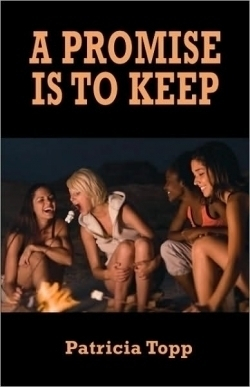A Promise Is To Keep
In A Promise Is To Keep, young readers will find their personal struggles in managing friendships, maintaining responsibility, and becoming a better person reflected in the summertime adventures of thirteen-year-old Barbara Kay, a naïve but well-intentioned teen spending her first summer away from home at Cass Lake Camp. Aimed at middle-grade readers, this novella aims to provide pre-teen readers with interior direction—a guide for the self-reflection that begins and intensifies at this integral stage in the lives of young girls.
Readers join Barbara Kay just before the start of summer. Having spent her spring working odd jobs for neighbors and friends, Barbara Kay has saved just enough money to attend camp with her best friend Nancy. Beginning with the challenge of spending her hard earned money wisely, Barbara Kay faces many obstacles on the road to self-improvement. Through classic camp situations—sharing bunks in a cabin, sunset scavenger hunts, swimming lessons, and baseball games—Topp attempts to create the culture of pre-teen female friendship through which Barbara Kay learns valuable life lessons.
Though the premise is admirable, the prose style Topp employs lacks the kind of energy that her subject matter and audience demands. Though middle grade fiction benefits from clear-cut prose, Topp’s style is overly simplistic and vague, lacking the specificity required to create the visual imagery necessary for any fiction, but especially important for young readers. This results in a surface-level treatment of important elements such as setting and character development. Aside from a very general idea of Barbara Kay’s desire to go to camp and be a better person, the reader does not get a satisfying sense of who she is, where she lives, the kind of life she leads, or the identity she wants to create for herself—all essential elements in pre-teen lives.
The issues Topp addresses—responsibility, reliability, leadership—are dealt with in sensitive and meaningful ways that will ring true to the reader. For example, early on, Barbara Kay is confronted by her friend Nancy who tells her she isn’t a dependable friend. This frank and honest confrontation with a well-meaning friend is touchy and uncomfortable, but will be meaningful among readers navigating their way through the tricky obstacles of middle-school dramas. However, the believability of Topp’s characters and their actions is called into question by an overly wholesome approach to issues that are important, but perhaps more suited to a younger age bracket. The thirteen-year-old girls in this book act much younger than their age, their emotional development is far behind that of typical teens who are dealing with far more heightened issues that go beyond the camp antics that Barbara Kay and her friends encounter.
The themes explored in this book are well suited to an eight to twelve age group and can certainly empower a young reader to take steps towards personal responsibility. However, the vague prose style, lack of specificity and detail, as well as inconsistent characterization must be revisited and addressed to create a meaningful story that will effectively impact its intended reader.
Reviewed by
Shoilee Khan
Disclosure: This article is not an endorsement, but a review. The publisher of this book provided free copies of the book and paid a small fee to have their book reviewed by a professional reviewer. Foreword Reviews and Clarion Reviews make no guarantee that the publisher will receive a positive review. Foreword Magazine, Inc. is disclosing this in accordance with the Federal Trade Commission’s 16 CFR, Part 255.

